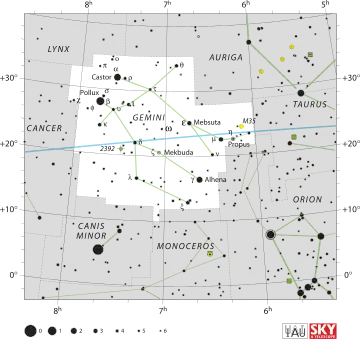Tau Geminorum
Tau Geminorum, Latinized from τ Geminorum, is a star in the northern zodiac constellation of Gemini. It has the apparent visual magnitude of +4.42,[2] making it visible to the naked eye under suitably good seeing conditions. This star is close enough to the Earth that its distance can be measured using the parallax technique, which yields a value of roughly 321 light-years (98 parsecs).[1]

 | |
| Observation data Epoch J2000.0 Equinox J2000.0 | |
|---|---|
| Constellation | Gemini |
| Right ascension | 07h 11m 08.37042s[1] |
| Declination | +30° 14′ 42.5831″[1] |
| Apparent magnitude (V) | +4.42[2] |
| Characteristics | |
| Spectral type | K2 III[3] |
| U−B color index | +1.41[2] |
| B−V color index | +1.261[3] |
| Astrometry | |
| Radial velocity (Rv) | +22.02±0.07[3] km/s |
| Proper motion (μ) | RA: -31.21[1] mas/yr Dec.: -48.92[1] mas/yr |
| Parallax (π) | 10.16 ± 0.25 mas[1] |
| Distance | 321 ± 8 ly (98 ± 2 pc) |
| Absolute magnitude (MV) | −0.56±0.05[3] |
| Details[3] | |
| Mass | 2.3±0.3 M☉ |
| Radius | 26.8±0.7 R☉ |
| Luminosity | 224[4] L☉ |
| Surface gravity (log g) | 1.96±0.08 cgs |
| Temperature | 4,388±25 K |
| Metallicity [Fe/H] | 0.14±0.10 dex |
| Rotational velocity (v sin i) | 5.8[5] km/s |
| Age | 1.22±0.76 Gyr |
| Other designations | |
| Database references | |
| SIMBAD | data |
It is an evolved giant star of the spectral type K2 III. It has double[4] the mass of the Sun and has expanded to 27[5] times the Sun's radius. Tau Geminorum is radiating 224[5] as much radiation as the Sun from its expanded outer atmosphere at an effective temperature of 4,528 K,[4] giving it the characteristic orange-hued glow of a K-type star. It appears to be rotating slowly with a projected rotational velocity of 5.8 km s−1.[5]
Planetary system
This star has a brown dwarf or Super-Jupiter companion designated Tau Geminorum b, whose mass is at least 20.6 Jupiter masses.[3] It was discovered in 2004 by Mitchell and colleagues, who also discovered Nu Ophiuchi b at the same time.[6] This brown dwarf takes 305 days (0.84 years) to revolve around Tau Gem. It may also have a stellar companion; a magnitude 11, K0 dwarf at a projected separation of about 187 AU.[3]
| Companion (in order from star) |
Mass | Semimajor axis (AU) |
Orbital period (days) |
Eccentricity | Inclination | Radius |
|---|---|---|---|---|---|---|
| b | ≥20.6 MJ | 1.17 | 305.5 ± 0.1 | 0.031 ± 0.009 | — | — |
References
- van Leeuwen, F. (November 2007), "Validation of the new Hipparcos reduction", Astronomy and Astrophysics, 474 (2): 653–664, arXiv:0708.1752, Bibcode:2007A&A...474..653V, doi:10.1051/0004-6361:20078357, S2CID 18759600
- Johnson, H. L.; et al. (1966), "UBVRIJKL photometry of the bright stars", Communications of the Lunar and Planetary Laboratory, 4 (99): 99, Bibcode:1966CoLPL...4...99J
- Mitchell, David S.; et al. (July 2013), "Precise radial velocities of giant stars. V. A brown dwarf and a planet orbiting the K giant stars τ Geminorum and 91 Aquarii", Astronomy & Astrophysics, 555: 10, arXiv:1305.5107, Bibcode:2013A&A...555A..87M, doi:10.1051/0004-6361/201321714, S2CID 32245543, A87.
- Luck, R. Earle; Heiter, Ulrike (June 2007), "Giants in the Local Region", The Astronomical Journal, 133 (6): 2464–2486, Bibcode:2007AJ....133.2464L, doi:10.1086/513194
- Massarotti, Alessandro; et al. (January 2008), "Rotational and Radial Velocities for a Sample of 761 HIPPARCOS Giants and the Role of Binarity", The Astronomical Journal, 135 (1): 209–231, Bibcode:2008AJ....135..209M, doi:10.1088/0004-6256/135/1/209, S2CID 121883397
- Mitchell, D. S.; et al. (2004), "Four Substellar Companions Found Around K Giant Stars", Bulletin of the American Astronomical Society, 35: 1234, Bibcode:2003AAS...203.1703M